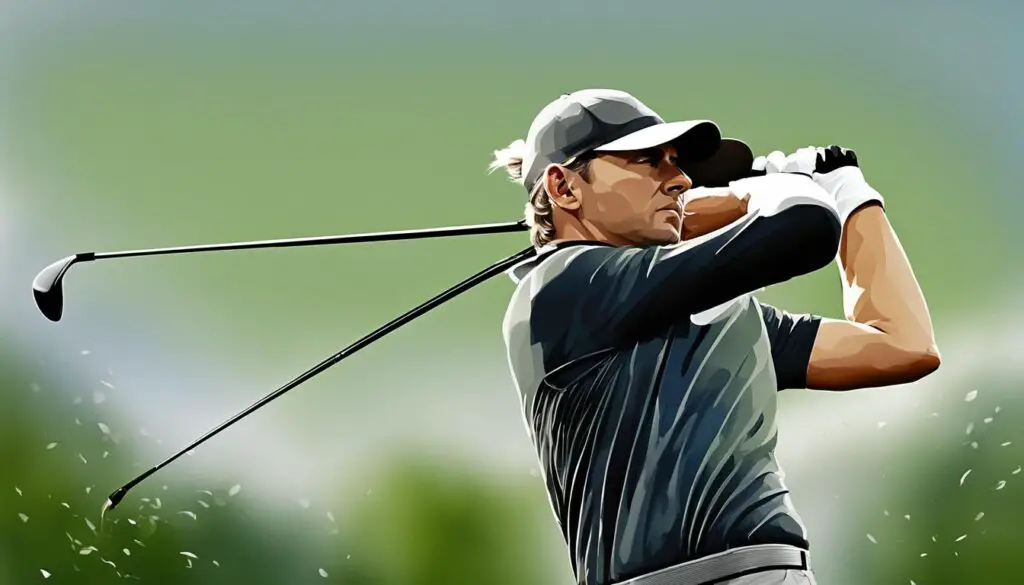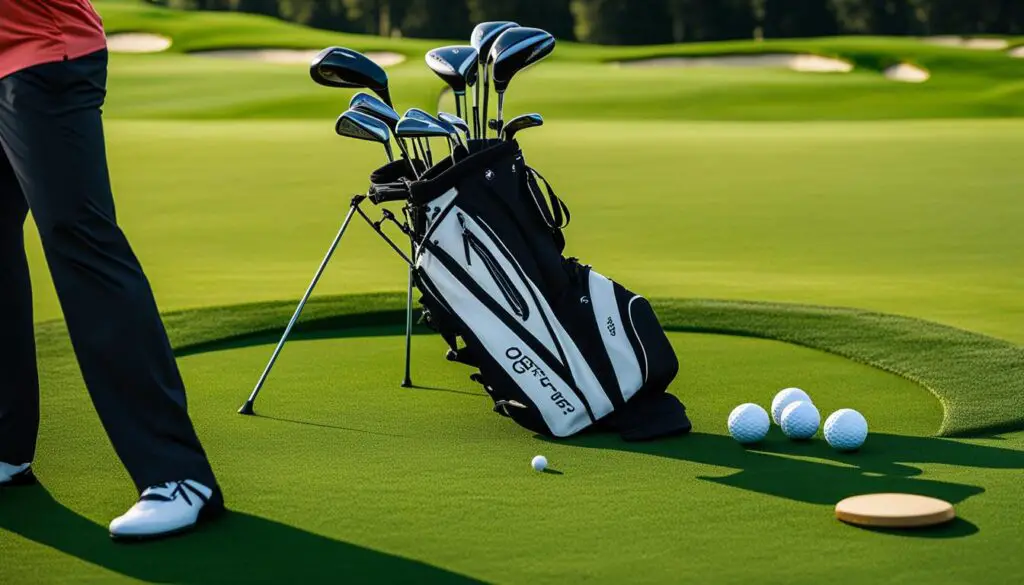Welcome to the world of golf! If you’re just starting out on your golfing journey, mastering the basics of the golf swing is essential. By understanding the key fundamentals and techniques, you’ll be on your way to developing a solid and consistent swing that will help you navigate the greens with confidence.
In this article, we’ll explore the essential elements of a golf swing technique, providing you with valuable tips to improve your skills. From the grip to the swing path, we’ll cover it all, ensuring you have a strong foundation to build upon as you progress in the game.
Key Takeaways:
- Master the fundamentals of grip, aim, stance, and posture before focusing on the swing itself.
- Develop a solid grip by understanding hand placement and grip pressure.
- Learn proper aim to align your body and club face towards the target.
- Set up for success with the right stance, posture, and ball position.
- Focus on building power and position in the backswing, and transferring energy and striking the ball effectively in the downswing.
The Grip: Getting a Solid Hold on the Club
When it comes to mastering the golf swing, one of the most fundamental aspects that beginners should focus on is the grip. A proper grip sets the foundation for a consistent and powerful swing, and it can make a significant difference in a golfer’s performance on the course.
So, what does a solid grip entail? It starts with proper hand placement. When gripping the club, beginners should ensure that their hands are placed in a neutral position, neither too strong nor too weak. This means that the “V” formed by the thumb and index finger of both hands should be pointing towards the right shoulder (for right-handed golfers) or the left shoulder (for left-handed golfers).
Grip pressure is another essential factor to consider. Beginners should aim for a firm yet relaxed grip on the club. Gripping the club too tightly can restrict the natural flow of the swing and lead to tension in the wrists and forearms. On the other hand, a grip that is too loose can cause the club to slip during the swing. Finding the right balance of grip pressure is crucial for optimal club control and swing mechanics.
In addition to hand placement and grip pressure, golfers should also pay attention to the position of their thumbs and fingers. The thumbs should be running down the front center of the grip, providing stability and control. As for the fingers, they should wrap around the grip naturally without any excessive pressure.
By getting a solid grip on the club, beginners can establish a strong foundation for their golf swing. Proper hand placement, grip pressure, and thumb and finger positioning are the key elements to focus on when working on the grip. With practice and attention to detail, golfers can develop a consistent and effective grip that helps them achieve better control, accuracy, and power in their swings.
Aim: Aligning Your Body and Club Face
Proper aim is a fundamental aspect of a successful golf swing. It involves aligning your body and club face towards the target. For beginners, understanding the correct alignment is key to promoting accuracy and consistency in their swings. In this section, we will explore the importance of aim and provide tips on how to achieve the proper target alignment.
To aim correctly, your body should be parallel left (for right-handed players) of the target, while the club face points towards the target. This alignment ensures that your swing is on the correct path, allowing you to strike the ball more accurately. It also helps prevent slices or hooks that occur when the club face is misaligned with the body.
One way to check your aim is to use alignment sticks or markers on the ground. Place one stick parallel to your target line and another stick perpendicular to your toes, forming a T shape. This visual aid can help you adjust your body and club face alignment until they are in sync with the target line.
Body Alignment Tips:
- Position your feet shoulder-width apart, with the majority of your weight on your leading foot.
- Align your hips and shoulders parallel to the target line.
- Ensure your eye line is directly over the ball or slightly inside the target line.
Club Face Alignment Tips:
- Grip the club with the correct hand placement, ensuring your leading hand’s V points towards your rear shoulder.
- Check that the club face is square to the target line at address.
- Use alignment aids, such as alignment sticks or alignment rods, to practice and fine-tune your club face alignment.
By mastering proper aim and alignment, beginners can set a strong foundation for their golf swings. With practice and attention to detail, you will develop a more consistent and accurate swing, leading to improved performance on the course.

Stance & Posture: Setting Up for Success
When it comes to a successful golf swing, proper stance and posture are essential. Getting the correct position not only allows for greater control but also helps generate power and consistency in your swing. Here are some key points to consider:
- Start with your feet shoulder-width apart to maintain balance and stability throughout the swing.
- Bend your knees slightly to create a solid base and enable proper weight transfer.
- Keep your back straight and avoid slouching. This allows for better rotation and helps maintain the correct swing plane.
- Position the ball slightly forward in your stance for most shots. This encourages a slight upward strike and optimal launch angle.
By focusing on these aspects of your stance and posture, you can establish a strong foundation for your golf swing. Remember to practice these fundamentals consistently to develop muscle memory and improve your overall performance on the course.
Common Mistakes to Avoid
While learning and improving your stance and posture, it’s important to be aware of common mistakes that can hinder your progress. Here are a few pitfalls to watch out for:
- Avoid standing too upright or leaning too far forward. Find the right balance that allows for comfortable movement and proper weight transfer.
- Don’t grip the club too tightly. Maintain a relaxed grip pressure to facilitate a smooth and fluid swing.
- Ensure your ball position is consistent. Placing the ball too far back or too far forward can lead to inconsistent strikes and accuracy issues.
- Be mindful of your body alignment. Aim your body parallel left (for right-handed players) of the target to promote an accurate swing path.
By recognizing and correcting these common mistakes, you can fine-tune your stance and posture, leading to a more effective and efficient golf swing.
The Backswing: Building Power and Position
When it comes to a powerful and effective golf swing, the backswing is a crucial element to master. The backswing sets the foundation for a well-executed downswing and ultimately impacts the accuracy and power of the shot. By focusing on key aspects such as rotation and hand position, beginners can develop a solid backswing that sets them up for success.
Rotation is an essential component of the backswing. As you take the club back, it’s important to rotate your shoulders and hips to create torque and generate power. This rotation not only helps build momentum but also helps set the proper body alignment for the downswing. By incorporating proper rotation into your backswing, you can add distance and consistency to your shots.
Hand position is another crucial factor in an effective backswing. Maintaining a firm yet relaxed grip on the club ensures control and stability throughout the swing. As you initiate the backswing, focus on keeping your hands in sync with the rotation of your body. This synchronized motion allows for a smooth and natural movement, setting the stage for a powerful downswing.

As you continue to practice and refine your backswing, remember to pay attention to rotation and hand position. These elements, when executed correctly, can greatly enhance the power and consistency of your golf swing. By building a strong backswing foundation, you’ll be well on your way to mastering the art of the golf swing.
The Downswing: Transferring Energy and Striking the Ball
Once you have mastered the backswing and positioned yourself for the downswing, it’s time to transfer the energy generated and strike the ball with precision. The downswing plays a vital role in determining the power and accuracy of your shot. To execute a successful downswing, focus on two key elements: weight shift and club path.
Weight Shift
Initiating the downswing with a proper weight shift from your back foot to your front foot is crucial for generating power and striking the ball cleanly. As you transition from the backswing, transfer your weight smoothly and gradually towards the target. This shift of weight will help you create a solid foundation and generate maximum clubhead speed, resulting in a powerful strike.
Club Path
The club path refers to the direction the clubhead travels during the downswing. To achieve consistent ball striking, it is essential to have a proper club path. Ideally, the club should follow a slightly inside-to-out path, allowing you to strike the ball squarely and promote a straight shot. Avoid swinging the club too steeply from the outside, as this can lead to slices or pulls.
By mastering the weight shift and club path during the downswing, you can enhance the transfer of energy and achieve more accurate and powerful ball strikes. Remember to practice these fundamentals consistently to develop a smooth and fluid downswing that aligns with your overall swing mechanics.
Tempo and Rhythm: Finding Your Groove
When it comes to mastering the golf swing, tempo and rhythm are often overlooked but essential factors. A smooth and controlled swing can make a significant difference in your game, allowing for better timing and improved accuracy. So how can you find your groove and develop a consistent swing tempo? Let’s explore some key tips and techniques.
1. Focus on the Count
One way to develop a steady rhythm is by counting in your head during the swing. This helps create a cadence that allows for a smooth and controlled motion. For example, you can count “1” during the backswing, “2” at the top of the swing, and “3” during the downswing. Experiment with different counts and find the rhythm that feels most natural to you.
2. Utilize a Metronome
A metronome can be an excellent tool for developing tempo and rhythm in your swing. Set the metronome to a comfortable pace and try to match your swing to the beats. This helps train your body to maintain a consistent tempo and promotes better timing. Over time, you’ll internalize the rhythm and be able to replicate it without the metronome.
“Tempo is the glue that holds the swing together.” – Ben Hogan
3. Stay Relaxed and Balanced
It’s crucial to stay relaxed throughout your swing and maintain a balanced posture. Tension in your muscles can disrupt the fluidity of your motion and throw off your tempo. Focus on breathing deeply and releasing any tension as you swing. Additionally, pay attention to your balance, ensuring that your weight is evenly distributed and centered throughout the swing.
Finding your groove in golf is an ongoing process that takes practice and patience. By incorporating these tips into your training routine, you can develop a consistent tempo and rhythm that will elevate your swing. Remember, a smooth and controlled swing leads to better timing, improved accuracy, and ultimately, a more enjoyable golfing experience. Keep practicing, stay dedicated, and watch your swing transform.

Grip Pressure Points: Fine-Tuning Your Hold
When it comes to mastering your golf swing, one crucial element that often gets overlooked is grip pressure. The way you hold the club can greatly impact your control, clubhead speed, and overall performance on the course. To optimize your grip, it’s important to understand the various pressure points and how they affect your club control.
The key to a proper grip is finding the right balance of firmness and relaxation. Gripping the club too tightly can restrict your wrist and forearm movement, leading to a rigid and inconsistent swing. On the other hand, gripping too lightly can result in a loss of control and power.
By paying attention to grip pressure points, you can fine-tune your hold and achieve a more fluid and controlled swing. Start by focusing on the pressure applied by your fingers. Maintain a firm but relaxed grip, ensuring that the club is securely held but not overly tight. Additionally, pay attention to the pressure between your palms and the club’s grip. Strive for equal pressure from both hands to promote a balanced and synchronized swing.
Remember, finding the right grip pressure may require some experimentation and practice. As you fine-tune your hold, pay attention to how it affects your swing and overall performance. Making grip pressure adjustments can lead to increased clubhead speed, improved accuracy, and a more confident swing.
Understanding Swing Path: Hitting the Sweet Spot
In golf, the swing path is a crucial factor that determines the trajectory and impact of the ball. It refers to the direction the clubhead travels during the swing and greatly affects the shot outcome. Understanding and controlling the swing path is essential for consistent ball striking and achieving that sweet spot connection.
To ensure a proper swing path, it is important to focus on clubface control throughout the swing. The clubface should be square to the target at impact, with the clubface angle influencing the ball’s initial direction. A closed clubface promotes a draw, while an open clubface tends to create a fade. By maintaining control of the clubface, golfers can influence the swing path and produce desired shot shapes.
Ball impact also plays a significant role in swing path. Striking the ball in the center of the clubface is crucial for maximum distance and accuracy. This sweet spot connection allows for optimal transfer of energy from the clubhead to the ball. Practicing consistent ball striking and developing a feel for the sweet spot helps golfers achieve a more reliable swing path.
Key Points:
- Swing path determines the trajectory and impact of the ball.
- Clubface control influences the swing path.
- Ball impact on the sweet spot is crucial for optimal distance and accuracy.

By understanding swing path and focusing on clubface control, golfers can improve their ball striking consistency and overall performance on the course. Practicing with intention, seeking professional guidance, and fine-tuning swing mechanics will contribute to a more refined and effective swing. Remember, hitting the sweet spot is the ultimate goal to unlock the full potential of your golf swing.
Finding Your Unique Swing: Personalizing Your Technique
When it comes to golf, each player has their own unique swing. While it’s important to learn and master the fundamentals, it’s equally important to personalize your technique to suit your individual style. By finding your unique swing, you can enhance your performance on the course and enjoy the game to its fullest.
Personalizing your technique starts with understanding your strengths and weaknesses. Take the time to assess your game and identify areas where you excel and areas that need improvement. This self-awareness will guide you in tailoring your swing to optimize your strengths and address any weaknesses.
Seeking guidance from a professional golf instructor can also be immensely helpful in finding your unique swing. They can analyze your swing mechanics, offer personalized advice, and help you develop a practice plan to improve your technique. With their expertise and knowledge, you can make targeted adjustments that will enhance your overall performance.
Remember, finding your unique swing is a journey of trial and error. It takes time, patience, and persistence. Embrace the process and be open to experimenting with different techniques and adjustments. Through practice and dedication, you’ll discover the swing that feels most comfortable and natural for you, leading to improved consistency, accuracy, and power in your shots.
Personalizing Your Technique: Key Points
- Assess your strengths and weaknesses to identify areas for improvement.
- Seek guidance from a professional golf instructor to receive personalized advice.
- Embrace the journey of trial and error to find the swing that suits you best.
- Practice regularly to refine and enhance your personalized swing technique.
Practicing with Training Aids: Enhancing Your Swing Mechanics
Practicing with training aids can significantly enhance your golf swing mechanics and help you improve your overall performance on the course. These aids provide instant feedback and allow you to focus on specific areas of improvement, accelerating your learning process.

One popular training aid that can benefit golfers of all skill levels is the “Lag Shot.” This device helps you develop a proper lag in your swing, which is crucial for generating power and achieving greater distance. The Lag Shot provides real-time feedback on your clubhead speed, helping you refine your tempo and timing. By incorporating this aid into your practice sessions, you can train your body to achieve the optimal position and improve your swing mechanics.
Another valuable training aid is the impact bag. It is designed to help you refine your ball striking by promoting proper hand and arm positioning at impact. By practicing your swing with the impact bag, you can develop a more consistent and accurate strike, resulting in better shot control and overall performance on the course.
Training aids can also help you improve your swing plane and clubface control. The swing plane trainer, for example, provides visual feedback on your swing path and helps you maintain the correct plane throughout your swing. This aids in increasing accuracy and reducing slice or hook tendencies. Additionally, using a clubface alignment device can help you ensure that your clubface is square at impact, leading to straighter shots and improved ball flight.
Benefits of Training Aids:
- Instant feedback: Training aids provide immediate feedback on your swing, allowing you to make adjustments and improve in real-time.
- Targeted practice: With training aids, you can focus on specific aspects of your swing and target areas that need improvement.
- Consistency: Regular practice with training aids helps develop muscle memory and promotes consistent swing mechanics.
- Efficiency: Incorporating training aids into your practice sessions allows you to maximize your training time and see faster results.
- Confidence: As you refine your swing mechanics using training aids, you’ll gain confidence in your abilities and perform better on the course.
“Training aids are invaluable tools for any golfer looking to improve their swing mechanics. By incorporating aids like the Lag Shot, impact bag, swing plane trainer, and clubface alignment devices into your practice routine, you can accelerate your progress and achieve a more consistent and powerful swing. Embrace the use of training aids as a means to enhance your golfing skills and take your game to the next level.”
Patience and Persistence: The Journey to Mastery
Mastery of the golf swing is a process that requires both patience and persistence. As beginners, it’s important to understand that improvement will come over time and with consistent practice. Don’t expect to master the swing overnight; instead, embrace the journey and commit to putting in the necessary work to refine your skills.
Practice is at the heart of improving your golf swing. Regularly dedicating time to practicing the fundamentals and honing your technique is essential for progress. Set aside specific practice sessions where you can focus solely on your swing mechanics, incorporating drills and exercises to target areas that need improvement. Remember, it’s not about the quantity of practice but rather the quality. Take the time to analyze your swing, seek feedback from a coach or experienced golfer, and make adjustments accordingly.
Over time, as you consistently practice and refine your swing, you’ll begin to see improvements. It’s important to remain patient during this journey, understanding that progress may come in small increments. Be mindful of the little victories and celebrate each milestone along the way. Mastery of the golf swing is not a destination but rather a continual pursuit of improvement. Embrace the challenges, learn from your mistakes, and keep pushing forward.
Conclusion: Elevating Your Golf Swing
Improving your golf swing is the key to achieving accuracy and power on the course. By focusing on the fundamentals and consistently practicing, you can take your game to the next level.
Developing consistent swing mechanics is crucial for achieving a reliable and powerful swing. Mastering the grip, aim, stance, and posture sets the foundation for a successful swing. By paying attention to these details, you can optimize your swing mechanics for better results.
Remember, improvement takes time and patience. With dedication and commitment to mastering the basics, you can unlock your full potential and enjoy a more consistent and powerful golf swing. Embrace the journey, stay persistent, and have faith in your ability to improve. Your hard work will pay off on the course!
FAQ
What are the key fundamentals beginners need to focus on when learning how to swing in golf?
Beginners should focus on the grip, aim, stance, and posture before diving into the swing itself. Mastering these foundational aspects sets them up for success as they progress in the game.
Why is the grip important in a golf swing?
The grip is crucial as it establishes a strong foundation for a consistent swing. Beginners should focus on hand placement, grip pressure, and the position of the thumbs and fingers.
What is proper aim in golf?
Proper aim involves aligning the club face and body towards the target. The body should be parallel left (for right-handed players) of the target, while the club face points towards the target.
What is the role of stance and posture in a golf swing?
Stance and posture play a crucial role in a golf swing. Beginners should focus on maintaining a shoulder-width stance, correct knee bend, straight back, and slightly forward ball position.
What should beginners focus on during the backswing?
During the backswing, beginners should focus on rotating the shoulders and hips while maintaining a firm yet relaxed hand position. This sets the stage for a strong and controlled downswing.
How can beginners improve their downswing?
Beginners should focus on initiating the downswing with a weight shift from the back foot to the front foot and ensuring a proper club path. This generates power and promotes accurate ball striking.
Why is tempo and rhythm important in a golf swing?
Tempo and rhythm are essential for timing and control. Beginners should strive for a smooth and controlled swing, focusing on maintaining a consistent tempo throughout their swing.
How does grip pressure affect a golf swing?
Grip pressure is critical for a proper golf swing. Beginners should understand the pressure points and how they affect club control. Proper grip pressure allows for a fluid and controlled swing.
How does swing path impact ball striking?
The swing path determines the ball’s trajectory and impact. Beginners should learn the proper swing path and understand how the clubface should be positioned at impact to achieve the desired shot outcome.
How can beginners find their unique swing?
While following the fundamentals, beginners should explore and personalize their technique to find what works best for them. Seeking guidance from a professional can help identify areas for improvement and develop a swing that suits their style.
Are training aids beneficial for improving swing mechanics?
Yes, training aids like the “Lag Shot” can provide instant feedback and help beginners work on specific areas of improvement. Incorporating training aids into practice sessions can accelerate the learning process and lead to significant swing improvements.
What does it take to master the golf swing?
Mastering the golf swing requires patience, persistence, and consistent practice. Improvement takes time, but by embracing the process and staying committed to practicing the fundamentals, golfers can continuously improve and develop a more confident swing.
